


Visitors to date:
© Zolf and Dr. One, 2006. All rights reserved.

Computing and Aerospace Era
I am Zolf and this is the continuation of my chronicles. Below, we repeat the previous entry for clarity. If you've somehow arrived here without seeing the earlier entries, CLICK HERE to go to the start of the chronicles.
EY1970, Light Probe #002463: This period demonstrated perhaps more successes than any since our first Light Probe #000001 in EY1890. The United States achieved their goal of a moon landing as part of the Apollo missions, with both Wulff and Hoffman employed with NASA contractors that were instrumental in the success of the Apollo. Hoffman was with TRW, developing Apollo simulation software for the NASA Johnson Spacecraft Center in Houston. Wulff was with General Electric (GE) at the Kennedy Space Station, where he was an active participant in GE field service support to Apollo 11, the first manned lunar landing. Our early guidance to their interests was resulting in both developing a keen understanding of aerospace and computing, two key topics required for those we choose to spread the message of our impending arrival.
Computing also evolved at a rapid rate during this period. The early super-computers were developed by Seymour Cray at Control Data Corporation (CDC), including the CDC 6500, which was the system that Hoffman used during his computing education at Florida State University. Upon graduation, he applied this knowledge in his work with NASA and this early exposure to computers proved to be key to his later success, which put him in a position to hire Wulff at GRC approximately 15 Earth Years later. This was also the period when the Astrian ideas seeded for the invention of the video game console, video-conferencing, and the ARPANET were acted upon by Earthlings in various locations on the globe. Without these three inventions, the software talents, world-wide communications, and publicly-available communications network necessary to achieve the level of technology planned by EY2006 would never have been possible.
While these successes were being realized, public awareness and curiousity relative to the Roswell UFO Incident, UFOs in general, inter-planetary travel, and alien encounters were being fueled by Star Trek and a wide collection of other television shows and movies.
EY1975, Light Probe #002504: We have during this period brought Hoffman together with one of his most influential mentors, a manager at TRW named John Brown. As a result Brown's direction and encouragement, Hoffman, who managed to get through 16 years of education without ever writing a term paper or authoring any product of significant length, has become a prolific writer. Brown instilled in Hoffman the value of extensive documentation to record accomplishments and experiences, to detail plans and objectives, and to aid in convincing an audience of the value and importance of specific desirable undertakings. It is this talent that will enable Hoffman to later provide the necessary documentary support to the Astrian mission. It is also this propensity to comprehensive documentation that Hoffman would later impart to Wulff some 10 Earth Years in the future, thus enabling Wulff to fulfill his role in the dissemination of the Astrian message to the world.
We were somewhat surprised by recent inventions of E-mail, the microprocessor, and the Ethernet. Although we suspect that these may possibly be residual to our earlier idea seeding, it is probable that these advances may have occurred with no interference from us. Whatever the source, these innovations are key to the eventual implementation of the world-wide web, also later referred to as the internet, which will enable us to spread our message so effectively in EY2006.
In contrast to the positive surprises in these computing areas, we also experienced some negative surprises regarding the Earthlings propensity towards conflict, hostility, and barbarous treatment of other Earthlings. The experience of the Viet Nam conflict, which we watched with interest and dismay, showed that the lessons of World War II were short-lived and it didn't require a single, maniacal dictator/leader to cause serious multi-national conflicts. Also during this period, we noted the emergence of the mentality dubbed the Cold War, whereby many areas of the Earth were thrown into a predator/prey mode, both among large super-powers and smaller, uninvolved nations. The struggle was named the Cold War because it did not actually lead to direct armed conflict between the superpowers (a "hot" war) on a wide scale. The Cold War was waged by means of economic pressure, selective aid, intimidation, diplomatic maneuvering, propaganda, assassination, low-intensity military operations and full-scale proxy war from EY1947 until the collapse of the Soviet Union in EY1991.
It was during this period that we identified an Astrian project related to the elimination of the predatory nature of all Earth beings, both human and animal, as being a necessary ingredient to the approval of Earth's continuance under the rules of the MWIS. The observance of the atrocities of Viet Nam, coupled with the nearly self-destructive results of the Cold War over the past 30 Earth Years, have convinced us that such a project is crucial to the success of our mission on Earth.
EY1980, Light Probe #003000: Major inventions this period include the digital camera, personal computer, laserdisc player, and cellular telephone. Although 3 of these, the digital camera, the laserdisc player, and the cellular telephone will prove to assist greatly in improving worldwide communication with both text and graphical images, the personal computer is the one that will be the most benefit to the Astrian cause. Although the Commodore computer invented during this period wasn't particularly popular, it was the fore-runner to the Apple and IBM personal computers that would soon follow. Without these personal computers, telling our story to the Earth in EY2006 would have been much more difficult for Hoffman and Wulff, if not impossible. It also hastened and facilitated a myriad of other technologies of great value to us, the most critical of is probably the internet.
During this period, Science Fiction flourished, with continuing tales of inter-galactic travel and encounters with alien species. Unfortunately, Astrian idea-seeding in this area had an unpleasant effect, due to two authors receiving many of the same ideas simultaneously. This conflict resulted in some plagiarism lawsuits and counter-suits, much to our dismay. In EY1978, 20th Century Fox (the producers of Star Wars in EY1977) sued Universal Studios (the producers of Battlestar Galactica in EY1978) for plagiarism, claiming it had stolen 34 distinct ideas from Star Wars. Universal promptly countersued, claiming Star Wars had stolen ideas from the EY1972 film Silent Running (notably the robot "drones") and the Buck Rogers serials of the 1940's. Thankfully, the lawsuit was eventually dismissed in EY1980 as being "without merit". Had we known that two very imaginative Earthlings, George Lucas and Glen Larson, were both destined to diligently pursue the same concepts, we might have been a little less clear with our ideas. This lesson taught us to disseminate the ideas in a vaguer form, in order that creations by multiple beings would be different enough to avoid disputes.
Our greatest success in the Science Fiction area was probably the film Close Encounters of the Third Kind,produced in EY1977. This film portrayed aliens in a much more positive light than either Star Wars or Battlestar Galactica, both of which involved a large amount of conflict with somewhat evil aliens. It also portrays the aliens as small, grey, friendly beings with no intention of waging war with Earth or dominating the beings of Earth, which is much closer to the actuality of Astrian visitors they will meet in EY2016.
During the same period, Hoffman is encouraged in several dream sequences to make a move from his aerospace interests in Houston to the defense industry in Huntsville, Alabama, where he will meet Wulff some 8 Earth-Years later. The move to Huntsville results in his again working with Wayne Smith, his mentor for a period in Houston and who will assist him in many critical life-changes during the remainder of his career.
EY1985, Light Probe #003110: Primary inventions during this period destined to support our cause are the internet protocol and the domain name system, both necessary to the introduction of the World-Wide Web, which we have been seeding in various forms since prior to EY1970. Due to the long period required for these inventions to mature enough to be available to the public, and more importantly to Wulff and Hoffman, it was necessary to introduce them in this time period. It would be nearly 10 Earth-Years later when our two information-disseminators would ultimately be introduced to the internet and become fervent users of its capabilities.
One of the major life-changes during this period resulted from Hoffman changing companies, giving him the opportunity to be introduced to recreational vehicles (RVs) as a means of supporting his zest for travel, as well as providing an avenue for the enhancement of his writing abilities. While on an RV trip that lasted nearly half of an Earth-Year, Hoffman wrote his first published book describing his travels. This was the first of several books and short stories that continued to mature his ability to eventually take him to the point where he would work with Wulff in EY2006 on the Aliens To Vegas novel that foretold the Astrian visit.
EY1990, Light Probe #003190: Soon after his RV trip, Hoffman returned to Huntsville and was joined at his new company by Wayne Smith. This change in companies for Hoffman and Smith led them both to the extensive use of the Apple computer, an experience later noted as being a close parallel to Hoffman's experience with Studebaker many Earth-years earlier. Like Studebaker versus the larger auto-makers in the 1950's, Apple Computer was a small company competing with a large company (IBM). Apple was more innovative, forward-thinking, futuristic, and more "before their time" than IBM, but lacked the effective marketing approach and corporate branding. Apple also didn't sufficiently appreciate the value of publicity, spreading the word of their accomplishments, satisfying the wants/needs of their prospective customers, and a large organization. These lessons were observed by Hoffman, just as he had observed the demise of Studebaker, and would be applied to our advantage when it came time to introduce the Astrians to Earth.
It was also during this period that Hoffman hired Wulff to join his software development group. That key event served to produce the highly unusual result of mutual mentoring between the two. Hoffman passed his propensity toward documenting everything to Wulff, who already had attempted some early excursions into authorship of several short stories, but had yet to attempt a full-fledged novel. Wulff's adventurous spirit and willingness to embark in new directions without more than a moment's consideration influenced Hoffman toward being less analytical and cautious in his approach to life in general. These combinations of influences were all necessary steps to enabling the two to be able to accept the later Astrian dream sequences describing their visit and subsequent influence on Earth's future.
This period produced the ultimate success for many of our earlier efforts, with the first implementation of the World Wide Web, thus enabling Hoffman and Wulff to spread the Astrian message throughout Earth. The underlying ideas of the Web can be traced as far back as EY1980, when Tim Berners-Lee built ENQUIRE. While it was rather different from the Web that later emerged, it contained many of the same core ideas.
In EY1989, Tim Berners-Lee wrote Information Management: A Proposal, which referenced ENQUIRE and described a more elaborate information management system. With help from Robert Cailliau, he published a more formal proposal for the World Wide Web on EY1990. He began implementing those ideas immediately, on a recently acquired NeXT workstation.
By the end of EY1990, Berners-Lee had built all the tools necessary for a working Web: the first Web browser (which was a Web editor as well), the first Web server and the first Web pages which described the project itself. In EY1991, he posted a short summary of the World Wide Web (WWW) project on the alt.hypertext newsgroup. This date also marked the debut of the Web as a publicly available service on the Internet.
The crucial underlying concept of hypertext originated with older projects from the 1960s, such as Ted Nelson's Project Xanadu and Douglas Engelbart's oN-Line System (NLS). Both Nelson and Engelbart were in turn inspired by Vannevar Bush's microfilm-based "memex," which was described in the EY1945 essay As We May Think. Although all of these innovations resulted from Astrian idea-seeding, we had applied lessons learned earlier in the Star Wars/Battlestar Galactica controversy, and transmitted the ideas in a highly generic form such that these inventors came up with related, but different, concepts.
Berners-Lee's brilliant breakthrough was to marry hypertext to the Internet. In his book Weaving The Web,he explains that he had repeatedly suggested that a marriage between the two technologies was possible to members of both technical communities, but when no one took up his invitation, he finally tackled the project himself. In the process, he developed a system of globally unique identifiers for resources on the Web and elsewhere: the Uniform Resource Identifier.
The WWW had a number of differences from other hypertext systems that were then available.
* The WWW required only unidirectional links rather than bidirectional ones. This made it possible for someone to link to another resource without action by the owner of that resource. It also significantly reduced the difficulty of implementing Web servers and browsers (in comparison to earlier systems), but in turn presented the chronic problem of broken links.
* Unlike certain applications, such as HyperCard, an Apple computer-related software package, the WWW was non-proprietary, making it possible to develop servers and clients independently and to add extensions without licensing restrictions. Here is yet another example of Apple not being responsive to user preferences by keeping Hypercard details proprietary and thus losing out on a great opportunity.
In EY1993, CERN, the European Organization for Nuclear Research, announced that the WWW would be free to anyone, with no fees due. This decision was largely due to an Astrian dream sequence initiated with the decision-makers at CERN, in order to ensure adequate public access to WWW information would be easily accessible to all Earthlings when the time of the Astrian visit approached.
The WWW finally gained critical mass with the EY1993 release of the graphical Mosaic web browser by the National Center for Supercomputing Applications developed by Marc Andreessen. Prior to the release of Mosaic, the Web was text based and its popularity was less than older protocols in use over the Internet, such as Gopher protocol and Wide area information server. Mosaics graphical user interface allowed the Web to become by far the most popular Internet protocol.
EY1995, Light Probe #003290: This period showed no particularly significant related inventions, other than the Pentium processor and HoTMaiL. The Pentium processor is significant in that it enabled developers to realize several major speed improvements in computer processor speeds over the ensuing years. The HoTMaiL concept allowed public access to WWW email capabilities, even if one wasn't signed up with a recognized internet provider. This enabled non-owners of computers to still use email, through access to computers in libraries and other free locations. HoTMaiL thus expanded the audience for the Astrian message to come.
The two more significant events that occurred during the period were the decisions of Hoffman and Wulff to take different directions in their path to ultimately retire in Florida and the production of the movie Stargate. The parting of paths was partially due to Wulff's influence on Hoffman to being more adventurous by deciding to attempt early retirement and to enjoy more of the RVing experience. Their employer in Huntsville had suffered some setbacks that required them to move to other pursuits. Wulff decided to continue following his software career in the Washington DC area, while Hoffman chose to retire early and try full-timing in an RV. Both of these directions were short-lived, but both provided them with experience and exposure to some new situations that would prove to positively influence their future writings. Wulff became more aware of the self-destructive tendencies of Earthlings that had been noted by Astrian observers for several decades. Hoffman gained more experience in writing and the world of RVing. After deciding to return to work in EY1995, Hoffman was presented with a position in an organization that was highly engaged in use of the internet, thus providing him with the training required to enable his later dissemination of the Astrian message using those same capabilities.

The most significant concept presented by the Stargate creations was the namesake stargate itself, a device that allows for almost instantaneous teleportation, by creating a wormhole to a complementary device on another planet. The story proposes that the stargate was discovered in EY1928 at Giza, Egypt, but the purpose of the alien device was unknown until the mid EY1990s. A top-secret military program was created to use the stargate, eventually for the purpose of exploration and interaction with extraterrestrial cultures. Although the stargate concept was an extreme simplification of the complexity of instantaneous teleportation, it closely mirrored the technique employed by Astrians for their light probes that are the basis for this entire historical log.
One aspect of the Stargate story that came as a complete surprise to us was the introduction, late in the TV series, of the concept of a ruling body of four highly-advanced races, who had power far surpassing the more familiar races of the series. These assembly of four races, which included the Asgard, bears an eerie similarity to the Milky Way Intelligentsia Society (MWIS). Although the MWIS is comprised of many more than four races, they're all highly advanced compared to the Earthlings, and possess many of the amazing powers of Stargate's four-race ruling body. The surprise came because we definitely hadn't implanted or seeded this idea, due to the fact that we intended to keep the MWIS a close-held secret until our EY2016 visit. It's early presentation in Stargate, however, will serve to simplify understanding of the MWIS by the Earthlings and should encourage the races of Earth to strive for participation in the organization.
EY2000, Light Probe #003410: This new millenium in Earth's history will be an opportune time to introduce the Earthlings to the idea that they're actually going to be visited by a non-Earthian species. As EY2000 approached, there was great concern ... CONTINUED IN THE NEXT CHAPTER ...
The significance of the EY1994 movie Stargate cannot be over-emphasized. This movie and the subsequent TV series presented a number of concepts which are very close to the reality of Astrian life and history. The concepts had been seeded around the world for a number of Earth-years, but weren't acted upon initially until EY1994, when creators Roland Emmerich and Dean Devlin released the Stargate movie. Although they moved on to other pursuits, the concepts were continued and expanded later by Jonathan Glassner and Brad Wright, when they later created the Stargate SG-1 series on TV in EY1997 (more on that topic in later entries). The Stargate movie and TV series embody several concepts highly similar to Astrian customs and technology. In both, the pyramid is highly significant in a variety of presentations, both as the transportation media for the Goa'uld alien race and as a link between alien visits and early Earth history. The TV series later introduced the Asgard race, whose appearance closely resembles that of Astrians and whose consciousness transferral to new bodies is highly similar to the Astrian brain copy into their pyramid-shaped android replacements.
Who is Zolf?
How is he related to these two old guys?
The full story is emerging on this website for your reading enjoyment!
If you'reinterested in knowing when updates are made, join the mailing list by contacting zolf_one@yahoo.com.
2007 Update: Read about the Astrian PREDATORS Project in Chapter 21 of Aliens to Vegas